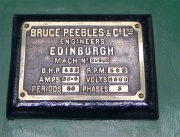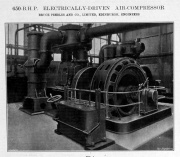

of East Pilton, Edinburgh.
1866 The company was founded as D. Bruce Peebles and Co by Scottish engineer David Bruce Peebles (1826-1899) in Edinburgh. The company initially specialised in gas engineering, for the manufacture of gas meters and gas appliances at Fountainbridge, Edinburgh.
1876 the works were moved to Tay Works, Leith
1897 Started to manufacture electrical machinery.
1890s Offering i/c engines [1]
1900 Supplied a 5-kilowatt shunt-wound motor for the Gloucester electricity supply works (Bruce-Peebles). [2]
1900 Manufactured 500 Amp balancer for the Port Dundas electricity works in Glasgow (D. Bruce Peebles and Co). [3]
1902 The name was changed to Bruce Peebles and Co. Ltd.
1903 The company, Bruce Peebles and Co, was registered on 24 June, to acquire the business of engineers of D. Bruce Peebles and Co. [4]. The business was electrical and gas engineers.
In 1904 the company opened a new factory at a site in East Pilton, on the north side of Edinburgh. This grew to become one of the largest producers of power transformers in Europe, employing 3,000 at its peak in the 1950s.
c.1906 Held a licence from Ganz of Budapest for their system of railway electrification.
1908 Became a public company.
1908 Display of Peebles-La Cour motor-convertor at the Manchester Exhibition[5]
By 1911 the company was concentrating on electrical plant[6]
1911 Electrical Exhibition. 475 kW motor converter and other items. [7]
1914 Engineers. Specialities: electrical machinery of all kinds, motor converters manufactured under the Peebles-La Cour patents. Employees 800. [8]
1920 650 bhp electrically driven air-compressor. [9]
1920 November. Shipbuilding, Engineering and Electrical Exhibition in Glasgow with enclosed motors for steel works. [10]
The company held the British manufacturing rights for the Cascade converter and a licence to manufacture three phase electrical equipment designed by Ganz of Budapest.
During both world wars, the works produced shells, submarine and aircraft parts, tank and electrical equipment such as mobile searchlights and mine sweeping units.
It also manufactured at least one (from an order of ten) electric locomotives for the Portmadoc, Beddgelert and South Snowdon Railway.
1924 Appointed Sellar Inglis and Co of Glasgow, as their agents fro the West and North of Scotland.[11]
1937 Engineers. "Peebles" Electrical Equipment. [12]
1947 It was the main sub contractor for the electrification of the Manchester - Sheffield railway line (the Woodhead route) from 1947 - 1954, a major engineering achievement. Throughout this period it specialised in large scale transformers for power stations, including the worlds largest 400kV 'quadrature booster' for the UK national grid. It also produced heavy electrical motors for various uses, including railway locomotives.
The works had its own internal railway system, which was electrified and used electric shunting locomotives built by Bruce Peebles themselves. This was the first electric line in Edinburgh (main line electrification did not reach Edinburgh until the early 1990s).
1961 Electrical engineers and manufacturers of electrical machinery including A.C and D.C generators, synchronous condensers, rectifiers, frequency chargers, automatic control and electronic equipment. 1,700 employees. [13]
1961 Acquired Belmos Co, who had the same chairman[14]
1969 The company became part of the Reyrolle Parsons Group, which then became part of NEI
Presumably known as Parsons Peebles
1984 Concentration of activities in Edinburgh, closing the leased plant in Birmingham and Cleveland, Ohio[15]
By the late 1990s it was owned by Rolls-Royce and the Austrian company VA Tech.
See Also
Sources of Information
- ↑ A-Z of British Stationary Engines by Patrick Knight. Published 1996. ISBN 1 873098 37 5
- ↑ The Engineer of 27th July 1900 p93
- ↑ The Engineer of 14th September 1900 p260
- ↑ The Stock Exchange Year Book 1908
- ↑ The Engineer 1908/10/16
- ↑ The Times, Jul 12, 1911
- ↑ The Engineer of 13th October 1911 p389
- ↑ 1914 Whitakers Red Book
- ↑ The Engineer of 7th April 1920 p482
- ↑ The Engineer of 19th November 1920 p504
- ↑ The Engineer 1924/01/18
- ↑ 1937 The Aeroplane Directory of the Aviation and Allied Industries
- ↑ 1961 Dun and Bradstreet KBE
- ↑ The Times Sep 26, 1961
- ↑ The Times, May 31, 1984
- [1] Wikipedia
- A-Z of British Stationary Engines by Patrick Knight. Published 1996. ISBN 1 873098 37 5






















